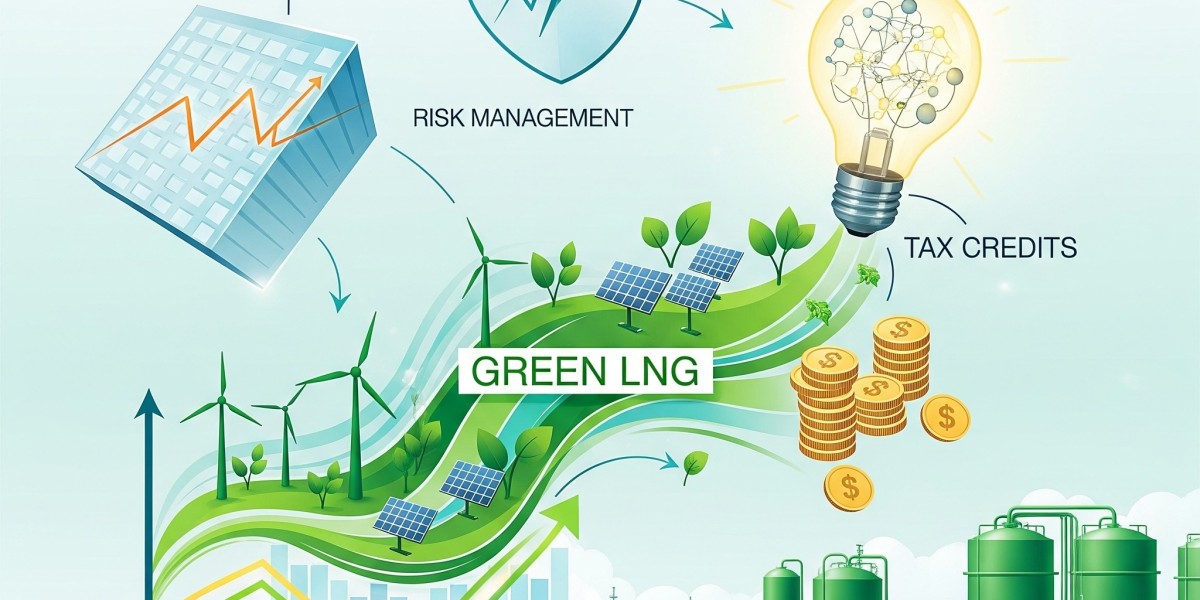Liquefied natural gas (LNG) has always been about bridging gaps: connecting regions with abundant gas to regions with surging demand, creating reliable trade flows, and stabilizing energy markets. But today, the conversation is shifting from “just LNG” to green LNG projects that aim to cut emissions, integrate renewable energy, and position themselves as viable players in a decarbonizing world.
For companies, investors, and governments, financing these projects isn’t just about pouring billions into steel and concrete. It’s about navigating tax credits, weighing investment risks, and betting on innovation that could make or break returns.
1. What Exactly Is Green LNG?
Green LNG doesn’t mean LNG itself has turned into a renewable fuel overnight. Instead, the “green” label comes from the measures taken to reduce its lifecycle carbon footprint:
Carbon Capture and Storage (CCS): Trapping CO₂ during liquefaction.
Renewable Integration: Using wind or solar to power parts of the LNG process.
Carbon Offsets & Credits: Purchasing certified offsets to neutralize emissions.
Efficiency Gains: Cutting methane leaks and using advanced turbine systems.
These changes don’t come cheap. But as global buyers—especially in Europe and Asia—start demanding lower-carbon LNG, producers must decide whether to pay the upfront costs now or risk being left behind in future trade.
2. The Role of Tax Credits
Tax incentives have become the cornerstone of making green LNG economically viable. Without them, many projects would stall under their own weight.
U.S. Production Tax Credits (PTCs): These reduce operational costs when renewable energy powers liquefaction.
Investment Tax Credits (ITCs): Offset capital expenditures on green tech such as CCS or hydrogen blending.
Carbon Capture Tax Credits (45Q in the U.S.): Companies earn up to $85 per ton of CO₂ permanently stored, a game-changer for LNG operators deploying CCS.
For Coastal Bend LNG, which is eyeing green LNG certification, such credits aren’t just accounting tricks—they directly impact financing terms. Banks and private equity are far more likely to back projects that can show government-supported revenue streams.
3. Investment Risk in Green LNG
Green LNG is capital-intensive, with projects often exceeding $10 billion. The risks fall into several buckets:
a) Market Risk
Global LNG demand is growing, but so is competition. Qatar, Australia, and the U.S. Gulf Coast all want a bigger slice. Green LNG could command a premium, but only if buyers accept higher prices. If not, producers may struggle to justify costs.
b) Regulatory Risk
Policies shift. A tax credit in place today might be cut tomorrow. Companies betting billions on long-term incentives must factor in political uncertainty.
c) Technology Risk
CCS, hydrogen integration, and advanced turbines are promising but not foolproof. If they fail to perform at scale, project economics collapse.
d) Financing Risk
Rising interest rates mean borrowing is more expensive. Green LNG projects often hinge on cheap debt to keep payback periods reasonable.
Investors don’t just ask, “Will this plant produce LNG?” They ask, “Will it produce LNG profitably, under different regulatory regimes, with scalable technology, and without stranded-asset risk?”
4. Innovation as the Differentiator
This is where innovation becomes the equalizer. Companies like Coastal Bend LNG are exploring:
Hybrid Power Systems: Using solar and wind to partially power liquefaction, cutting gas consumption.
Next-Gen CCS: More efficient capture with lower parasitic energy load.
Digital Optimization: AI-driven predictive maintenance reduces downtime and extends equipment life.
Green Financing Instruments: Issuing sustainability-linked bonds or tapping ESG-focused funds.
Here’s the thing: innovation isn’t just about technology. It’s also about financial innovation. The way deals are structured—whether through public-private partnerships, export credit agencies, or green bonds—can make projects bankable.
5. Global Implications
The story of financing green LNG extends beyond Coastal Bend LNG. It’s about:
Energy Security: Nations want cleaner fuels but not at the cost of reliability.
Climate Goals: Green LNG is a bridge fuel, not an endpoint, but it helps countries hit emissions targets while scaling renewables.
Capital Markets: ESG-conscious investors are watching closely. Firms that can prove carbon reductions get cheaper financing.
6. Looking Ahead
Here’s the reality: financing green LNG is messy. Tax credits can disappear, markets can shift, technologies can fail. But the upside is huge. Producers who figure out the puzzle—balancing policy support, risk management, and innovation—stand to capture premium markets and long-term investor trust.
Coastal Bend LNG’s trajectory will be a bellwether. If it cracks the financing code, it shows the world that green LNG isn’t just a talking point—it’s bankable business.
Final Thoughts
The transition to green LNG isn’t optional; it’s inevitable. Tax credits give projects the runway, investors demand risk mitigation, and innovation provides the edge. Coastal Bend LNG and its peers are navigating this tightrope right now.







